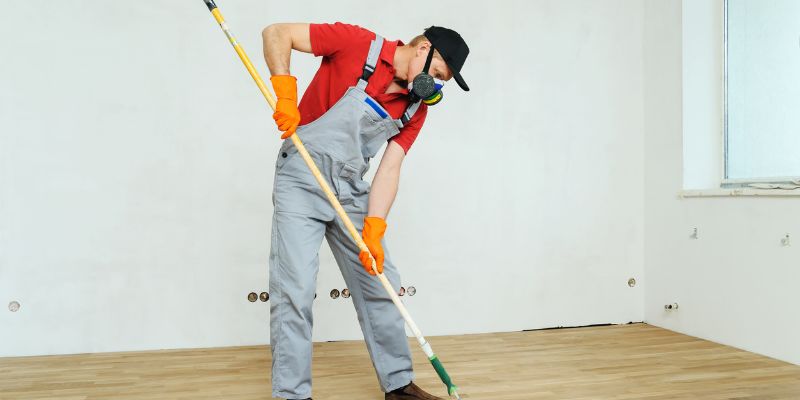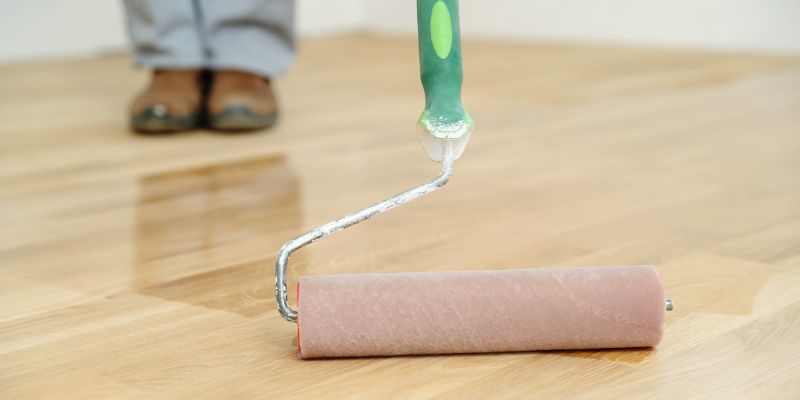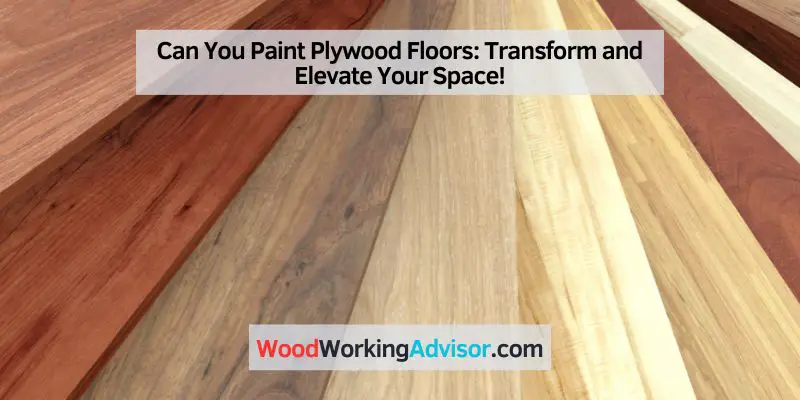Yes, you can paint plywood floors to give them a fresh and updated look. Paint can be a cost-effective and versatile solution for transforming plywood floors, as it can add color, hide imperfections, and create a durable and easy-to-clean surface.
By following proper preparation and application techniques, you can achieve a professional-looking finish that will enhance the overall appearance of your floors. Whether you want to add a pop of color or create a sleek and modern look, painting plywood floors can be a great option for any budget-conscious homeowner or DIY enthusiast.
Benefits Of Painting Plywood Floors
Plywood floors are not only durable and cost-effective but can also be enhanced with a fresh coat of paint. Painting plywood floors offers numerous benefits, enhancing the aesthetic appeal, providing an affordable flooring solution, and allowing for customization. Whether you have old, worn-out plywood floors that need a facelift or new plywood floors that could use a touch of personalization, painting them is an excellent option to consider.
Enhances The Aesthetic Appeal
Painting plywood floors can dramatically transform the look and feel of any space, enhancing its aesthetic appeal. By choosing the right color and finish, you can create a cohesive and visually stunning design that complements the overall décor. Whether you opt for a bold and vibrant color to make a statement or a neutral tone to achieve a more understated elegance, painted plywood floors can add a touch of uniqueness and personality to your interior.
Cost-effective Flooring Solution
Plywood floors are already a cost-effective flooring option, and by painting them, you can achieve a beautiful finish without breaking the bank. Compared to other flooring materials and installation methods, painting plywood floors is a budget-friendly alternative that can help you save money. Additionally, it eliminates the need for costly carpeting or expensive hardwood flooring, making it an ideal option for those on a tight budget or looking for a cost-effective solution.
Allows For Customization
One of the greatest benefits of painting plywood floors is the ability to customize them according to your preferences. Whether you want to create a vibrant pattern, a faux tile effect, or an intricate design, painting allows for endless possibilities. You can let your creativity soar and transform your plywood floors into a unique canvas that reflects your personal taste and style. With a little imagination and the right techniques, you can achieve a stunning result that showcases your individuality.
| Benefits |
|---|
| Enhances the aesthetic appeal |
| Cost-effective flooring solution |
| Allows for customization |

Preparing Plywood Floors For Painting
Painting plywood floors is a feasible option that can transform the look of your space. However, proper preparation is crucial to ensure a successful and long-lasting result. From cleaning and sanding to priming and painting, following the right steps will ensure a smooth and durable finish.
Before you embark on painting your plywood floors, it’s crucial to take the time to properly prepare the surface. By following a few simple steps, you can ensure that your paint adheres well and results in a durable and beautiful finish. In this section, we will guide you through the process of preparing your plywood floors for painting.
Clean The Surface Thoroughly
Begin by cleaning the plywood surface thoroughly to remove any dirt, dust, or debris. Use a broom or vacuum cleaner to sweep away loose particles, and then mop the floor with a mild detergent and warm water. Make sure to rinse off any soap residue to prevent a sticky surface. Allow the plywood to dry completely before proceeding to the next step.
Repair Any Damages
Inspect your plywood floors for any damages such as cracks, holes, or loose boards. If you come across any imperfections, take the time to repair them before proceeding with painting. Fill any cracks or holes with wood filler, ensuring that it is level with the surface. For loose boards, use screws or nails to secure them in place. Sand down any rough edges or splinters to create a smooth surface for painting.
Sand The Plywood
Using sandpaper or a sanding machine, gently sand the plywood surface to enhance paint adhesion. This step will ensure a more even and professional-looking finish. Start with a coarse grit sandpaper to remove any existing finish or rough spots, and gradually move to a finer grit to achieve a smooth surface. Make sure to wipe away any sanding dust with a damp cloth and let the plywood dry completely before proceeding to the next step.
Apply Primer
Priming your plywood floors is essential to enhance paint adhesion and improve longevity. Apply a good quality primer specifically formulated for plywood surfaces. Use a brush or roller to evenly coat the entire floor, paying attention to corners and edges. Allow the primer to dry completely according to the manufacturer’s instructions before proceeding to the final step.
By thoroughly cleaning the surface, repairing any damages, sanding the plywood, and applying primer, you can ensure that your painted plywood floors will not only look stunning but also withstand daily wear and tear. Following these steps will provide a strong foundation for your paint and help you achieve beautiful and long-lasting results.
Choosing The Right Paint For Plywood Floors
Painting plywood floors can be a simple and cost-effective way to transform your space. Discover the right paint for plywood floors and learn how to create a beautiful and durable finish that will withstand daily wear and tear.
Selecting The Suitable Finish
When it comes to painting plywood floors, selecting a suitable finish is crucial for achieving the desired result. The finish not only enhances the appearance of the floor but also protects it from wear and tear. There are various types of finishes available for plywood floors, each with its own unique characteristics and benefits.
Considering Durability And Resistance
Durability and resistance are important factors to consider when choosing the right paint for plywood floors. Since floors are subject to constant foot traffic, it is essential to select a paint that can withstand heavy use and resist scratches, scuffs, and stains. Additionally, considering the moisture levels in the area is crucial to ensure the paint can withstand humidity and potential water spills.
Evaluating Color Options
When it comes to painting plywood floors, evaluating color options is an exciting part of the process. The color you choose can have a significant impact on the overall look and feel of the space. Whether you prefer neutral tones for a timeless appeal or bold colors to make a statement, consider the existing decor and the atmosphere you want to create. It’s also important to keep in mind that lighter colors can make the space feel larger, while darker colors can add warmth and coziness.
Applying Paint To Plywood Floors
When it comes to revitalizing your plywood floors, one cost-effective option is to apply a fresh coat of paint. Not only can painting plywood floors give them a new lease of life, but it also allows you to introduce a pop of color or create a unique design element in your space. In this blog post, we will guide you through the process of applying paint to plywood floors, from the tools and materials you’ll need to the step-by-step application process.
Tools And Materials Needed
To get started with painting your plywood floors, you will need the following tools and materials:
- Painter’s tape
- Drop cloths or plastic sheets
- Paint roller
- Paint tray
- Paintbrush
- Primer (specifically formulated for floors)
- Floor paint (latex or oil-based, depending on your preferences)
- Sanding block or orbital sander
- Tack cloth
- Cleaner or degreaser
Applying The First Coat
Once you have gathered all the necessary tools and materials, you can begin the process of painting your plywood floors. Here are the steps to follow for applying the first coat:
- Prepare the surface by cleaning it thoroughly. Remove any dust, dirt, or grease using a cleaner or degreaser.
- Apply painter’s tape along the edges of the floor to protect baseboards and walls from paint splatters.
- Place drop cloths or plastic sheets to cover any furniture or fixtures in the room.
- If the plywood is untreated or bare, apply a coat of primer using a paint roller or brush. Allow the primer to dry completely before proceeding.
- Open the container of floor paint and stir it well to ensure even consistency.
- Pour a small amount of paint into the paint tray and saturate the roller.
- Start in a corner of the room and begin rolling the paint onto the plywood in smooth, even strokes. Work your way towards the exit to avoid stepping on freshly painted areas.
- Allow the first coat of paint to dry according to the manufacturer’s instructions before proceeding to the next step.
Sanding Between Coats
To achieve a smooth and professional finish, it is recommended to lightly sand the floor between coats of paint. Follow these steps:
- Use a sanding block or orbital sander with a fine-grit sandpaper.
- Gently sand the surface of the painted plywood, focusing on any imperfections or rough spots.
- Wipe away the dust using a tack cloth to ensure a clean surface for the next coat of paint.
Applying Subsequent Coats
Once the first coat is dry and you have sanded the surface, it’s time to apply subsequent coats of paint. Follow these steps:
- Repeat the process of pouring paint into the tray and saturating the roller.
- Start from the corner where you left off and apply the paint in the same manner as the first coat.
- Allow each subsequent coat to dry completely before proceeding to the next. This may require multiple coats to achieve the desired color and finish.
By following these steps and using the recommended tools and materials, you can successfully paint your plywood floors and transform the look of your space. Remember, proper surface preparation, application techniques, and allowing sufficient drying time are key to achieving a durable and beautiful finish.

Protecting And Maintaining Painted Plywood Floors
Plywood floors are a cost-effective and versatile option that can be transformed with a fresh coat of paint. Whether you’re revamping your home or giving new life to an old space, painting plywood floors is a popular choice. However, to ensure the longevity and durability of your painted plywood floors, it’s essential to protect and maintain them properly. In this article, we will explore some important steps to help you protect and maintain your painted plywood floors effectively.
Applying A Protective Sealant
To safeguard your painted plywood floors from wear and tear, it’s crucial to apply a protective sealant. A sealant acts as a barrier between your floor and common hazards such as foot traffic, spills, and scratches. It also enhances the durability of your painted surface, preventing the paint from chipping or fading over time. To apply a protective sealant, follow these simple steps:
- Ensure your painted plywood floor is clean and dry. Remove any dust or debris using a broom or vacuum cleaner.
- Choose a suitable sealant for your floor, such as polyurethane or varnish. Read the manufacturer’s instructions for the recommended application method and drying time.
- Using a clean brush or roller, apply the sealant evenly on the surface of the floor. Start from one corner and work your way towards the exit point to avoid stepping on the freshly coated area.
- Allow the sealant to dry completely as per the instructions. This may take a few hours or even overnight.
- If desired, apply a second coat of sealant for added protection and durability.
Regular Cleaning And Maintenance
Regular cleaning and maintenance are essential for keeping your painted plywood floors looking their best. Follow these tips to maintain their appearance and extend their lifespan:
- Use a soft-bristle broom or microfiber mop to sweep or dry mop the floor regularly. This helps remove dust, dirt, and debris that can scratch the painted surface.
- For routine cleaning, dampen a mop or cloth with mild soapy water and gently mop the floor. Avoid using harsh chemicals or abrasive cleaners that may damage the paint.
- Wipe up spills immediately to prevent staining or damage to the painted surface. Blot the spill with a clean cloth or paper towel and rinse the area with water if necessary.
- Place mats or rugs at entryways and high-traffic areas to protect the floor from dirt and grit.
- Avoid dragging heavy furniture or sharp objects across the floor to prevent scratches. Use furniture pads or sliders to move heavy items without causing damage.
Addressing Potential Issues
While painted plywood floors are durable, there are some potential issues you may encounter over time. Here are a few common issues and how to address them:
| Issue | Solution |
|---|---|
| Scratches or scuffs | Touch up the affected area with paint using a small brush or roller. |
| Yellowing or fading | Apply another coat of paint or consult a professional for color matching and repainting. |
| Peeling or chipping | Scrape off the loose paint, sand the area gently, apply primer, and repaint the affected section. |
| Moisture damage | Identify and address the source of moisture, repair any leaks or issues, and allow the floor to dry thoroughly before repainting. |
By applying a protective sealant, regularly cleaning and maintaining your painted plywood floors, and addressing any potential issues promptly, you can ensure their longevity and keep them looking beautiful for years to come.
Alternative Design Ideas For Painted Plywood Floors
When it comes to updating your plywood floors, painting them is a budget-friendly and creative solution. Not only does it hide imperfections, but it also adds a pop of color and personality to your space. But why settle for a plain and boring painted floor? In this article, we explore some alternative design ideas that will elevate your painted plywood floors and make them truly stand out.
Creating Stenciled Patterns
Stenciling is a popular technique that allows you to add intricate and eye-catching patterns to your painted plywood floors. Whether you prefer geometric shapes, floral motifs, or playful designs, stenciling gives you the freedom to personalize your floors and create a unique look. Simply trace the stencil onto the floor surface using painter’s tape, and then fill in the design with your chosen colors. The result is a stunning and bespoke pattern that adds depth and visual interest to your space.
Using Multiple Colors
Who says you have to stick to just one color when painting your plywood floors? Using multiple colors can take your design to the next level and create a vibrant and dynamic look. Consider incorporating a color gradient, where one color transitions into another, for a mesmerizing effect. Alternatively, you can experiment with a checkerboard pattern using contrasting colors for a bold and dramatic statement. Using multiple colors allows you to unleash your creativity and add a touch of whimsy to your space.
Adding A Faux Rug Effect
If you want to add a touch of elegance and sophistication to your painted plywood floors, consider creating a faux rug effect. This technique involves painting a border around the perimeter of the floor, leaving the center area as a faux rug. The faux rug can be a solid color or feature a pattern that mimics a traditional rug design. This design idea adds visual interest and can act as a focal point in a room. It also gives the illusion of an actual rug without the high cost or maintenance.
Conclusion
Painting plywood floors can be a cost-effective and creative way to transform your space. By choosing the right paint and following the necessary steps, you can achieve a durable and attractive finish. Whether you opt for a solid color or get artistic with stencils or patterns, this DIY project allows for endless possibilities.
So, go ahead and unleash your creativity on your plywood floors – the results are sure to impress!



2 thoughts on “Can You Paint Plywood Floors: Transform and Elevate Your Space!”